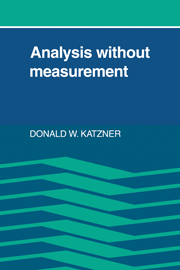Book contents
- Frontmatter
- Contents
- Preface
- Dedication
- 1 Introduction
- 2 Notes on measurement
- Part I Theoretical methods
- Part II Applications to theoretical problems
- Part III Empirical verification
- 12 Statistical background
- 13 Empirical relations among variables
- 14 An empirical application: occupational preferences and the quality of life
- 15 Getting on without measures
- Index
12 - Statistical background
Published online by Cambridge University Press: 04 August 2010
- Frontmatter
- Contents
- Preface
- Dedication
- 1 Introduction
- 2 Notes on measurement
- Part I Theoretical methods
- Part II Applications to theoretical problems
- Part III Empirical verification
- 12 Statistical background
- 13 Empirical relations among variables
- 14 An empirical application: occupational preferences and the quality of life
- 15 Getting on without measures
- Index
Summary
So far attention has been directed primarily toward the achievement of two major goals. First, a general methodology was developed to handle variables that seem incapable of measurement. Rules and guidelines enabling construction and manipulation of relations among such variables are thus available. These relations are basic components of the modern systems approach to analysis in social and behavioral science. Simultaneous equations systems, systems of periodic equations, and models of choice have received particular emphasis. The inescapable conclusion is that, except for measurement, nonquantifiable experience may be approached and understood in much the same way as is traditionally realized when the standard quantitative yardsticks are available.
The second goal was to demonstrate, at least at theoretical levels, how this methodology could be applied. Four examples were given: Political structure was defined as a system of simultaneous equations that may determine political systems or cycles. A dynamic model for planning purposes was presented along with a more complex account of society's process of social, political, cultural, economic, and psychological evolution. Lastly, the firm was modeled and analyzed in terms of the social interactions of the individuals it employs. In all instances, knowledge of structural relations and parameter values would, as in the quantifiable case, permit prediction.
Scientific inquiry, however, involves not only the creation of structure, theoretical propositions, predictions and the like, but also the determination of whether the structure, propositions, and predictions manifest themselves empirically. Accordingly, here in Part III, focus shifts to ways of obtaining specific knowledge of parameters and relations for the purpose of prediction or “empirical verification.”
- Type
- Chapter
- Information
- Analysis Without Measurement , pp. 233 - 252Publisher: Cambridge University PressPrint publication year: 1983



